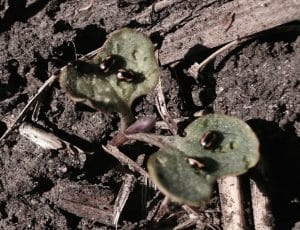Here are five important points to help with flea beetle scouting and management:
1. Flea beetle damage can advance quickly. The action threshold for flea beetles in canola is when average leaf area loss reaches 25% or more. Foliar insecticide provides an economic benefit when damage reaches 50%, but feeding can advance very quickly from 25% to 50% leaf area loss — especially in warm and calm days — so 25% is the action threshold.
Frequent scouting is required, particularly if the crop is growing slower than the flea beetles are eating. Scout the same areas each time as feeding damage can vary across the field. Leave flags if necessary. Pay particular attention to new growth as this is the only way to accurately identify recent feeding. Read more on the 8 steps to make a spray decision.
2. Flea beetles will keep eating on cool days. Crucifer flea beetles, the most common all-black species, will reach peak emergence when soil temperatures reach 14-15°C. Striped flea beetles tend to emerge earlier. But once flea beetles have emerged from winter dormancy, they will keep feeding – even at cooler temperatures.
The difference is that while flea beetles tend to fly around on calm days with temperatures above 15°C, they will walk and hop from plant to plant on cooler days.
3. Spray can be effective on cool days, but not wet days. Insecticide will be effective on cooler days as long as the flea beetles are active. Malathion is the only product that requires a minimum temperature of 18-20°C. Other product labels say to apply when flea beetles are active, but to avoid the warmest parts of the day. Some specify that they should not be applied when temperature are above 25°C.
However, if conditions are cool AND wet, don’t spray. Flea beetles take cover in the soil during rainfall. Product labels also say not to spray if rain is likely within one hour.
4. Stem feeding can be more damaging than leaf feeding. While flea beetles may not do much on wet days, on cool and windy days they will move down to stems and keep feeding. There is no set economic threshold for stem feeding, but if the stem is chewed through or leaf stalks are severed, leaf area loss will be 100%. If flea beetles are primarily on stems, consider 25% plant stand loss to flea beetle feeding as the point where action may be warranted.
Sprays work through contact and ingestion, and are therefore more effective when flea beetles are on top of leaves and exposed to direct contact. Some contact will occur when flea beetles are on stems, and as long as water volumes are sufficient and there is no rain in the near forecast, ingestion will also provide some control. See the table below.
5. Seed treatments are less effective on striped flea beetles. Current neonicotinoid-based canola seed treatments are not as effective on striped flea beetles as they are on crucifer flea beetles. However, the same level of scouting is required to determine the potential need for a foliar insecticide application.
Seed treatments may also be close to the end of their 28- to 35-day protective period. Some early seeded crops, provided they were in moist soils and started to take up moisture right away, will start to lose this protection by now. This is particularly important in fields that have been slow to develop, and do not reach the four-leaf stage — the stage when canola plants are no longer as vulnerable to flea beetle feeding — within the seed treatment’s protective period.
More…
- Canola Encyclopedia chapter on flea beetles – which describes the insect and provides management tips.
- How to assess leaf area loss from flea beetles
- How to make the flea beetle spray decision


